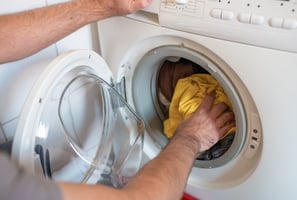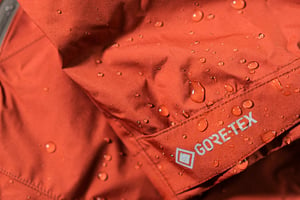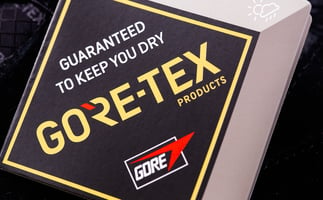Hello, today I'd like to talk about DWR (water-repellent treatment), which many people...
Can Heat Restore Waterproof Performance? The Truth from Experiments and Case Studies
Hello outdoor enthusiasts! Today we're going to thoroughly examine the claim that "applying heat to rain gear restores its waterproof performance" to determine if this is actually true. In this article, we'll organize the facts based on expert opinions and actual experiment results, and introduce proper maintenance methods.
Waterproof Performance and Water-Repellent Performance Are Different
First and foremost, I want to clarify that what can be restored is not waterproof performance, but water-repellent performance.
Many people confuse these two, but they are completely different functions:
- Waterproof Performance: The ability to prevent water from passing through the fabric
- Water-Repellent Performance: The ability to prevent water from being absorbed by the fabric, causing it to bead up and roll off the surface
For rain gear, waterproof performance is achieved through membranes such as Gore-Tex or waterproof resin coatings. On the other hand, water-repellent performance comes from special chemical treatments applied to the fabric surface (DWR: Durable Water Repellent).
Waterproof Performance Cannot Be Restored with Heat
There are mainly two causes of decreased waterproof performance:
- Physical damage (holes, tears, etc.)
- For coated items, aging of the coating resin
Neither of these can be restored with heat treatment. Especially with coated-type waterproof resin materials, applying heat might actually accelerate deterioration.
Once waterproof coating has deteriorated, restoration is unfortunately difficult. For membrane types (such as Gore-Tex), the membrane itself rarely loses its waterproof performance, but if waterproofing does decline once, heat treatment will not restore it.
Water-Repellent Performance May Be Restored with Heat
On the other hand, water-repellent performance may be restored with heat treatment depending on the cause of deterioration. Here are the three main causes of reduced water repellency:
1. Surface Dirt Accumulation
When oils, mud, or other dirt adheres to the fabric surface, the water-repellent effect is compromised. In this case, washing to remove the dirt may restore water repellency.
2. Familiarity with Water
The resin used in water-repellent treatments changes its properties when exposed to water for long periods, reducing the water-repellent effect. This is called "familiarity with water." When heat is applied to fabric in this condition, the resin can be reactivated to approach its original state, potentially restoring water repellency.
3. Peeling of Water-Repellent Components
When the fabric wears down from use or water-repellent components fall off, the water-repellent effect is lost. In this case, heat treatment alone is not sufficient, and retreatment with a water-repellent agent is necessary.
Does Heat Treatment Really Work?
Several experimental results confirm that appropriate heat treatment can be effective in restoring water repellency.
Verification Experiment by Akimama
The outdoor website Akimama conducted an experiment applying an iron to rain gear with reduced water repellency. Using a pressing cloth and applying iron heat from low to medium temperature, they found that water beaded up and rolled off when water was applied. Akimama's reporter noted, "Maybe it's just my imagination, but the iron seemed to produce better results and better water repellency restoration than using a dryer for heat treatment."
Hairdryer Experiment by ForR
The motorcycle equipment site ForR conducted an experiment applying hairdryer heat to rain gear. Keeping the hairdryer more than 10cm away from the surface fabric and applying heat for about 30 seconds per area, they reported that "the surface fabric repelled water beautifully, forming round water droplets." In simple terms, water-repellent bases that had "laid down" due to friction or dirt "stood back up" due to heating, restoring their effectiveness.
Correct Methods of Heat Treatment
There are several methods for heat treatment to restore water repellency. Always check the product's washing instructions before proceeding with any method.
1. Using a Dryer (Most Recommended)
- Low temperature setting (about 60°C) for about 20 minutes
- Advantages: Heat is applied uniformly throughout
- Caution: Check washing instructions to confirm if dryer use is allowed
2. Using an Iron
- Always use a pressing cloth
- Low to medium temperature setting (varies by material)
- Don't press down hard
- Avoid applying to logo marks or waterproof zippers
- Caution: May result in uneven treatment by area
3. Using a Hairdryer
- Keep about 10cm away from the surface
- Apply warm air of about 60°C for about 30 seconds per area
- Caution: Prolonged application may damage the material
When Heat Treatment Alone Is Insufficient
In some cases, water repellency may not be restored by heat treatment alone depending on the cause. Here are solutions for such cases:
1. Washing with Specialized Detergent
If skin oils or dirt have accumulated, washing with detergent specifically designed for outdoor wear may restore water repellency. Regular laundry detergents may contain components that remain on clothing and potentially interfere with re-waterproofing treatment, so specialized detergents are recommended.
2. Retreatment with Water-Repellent Agents
If water-repellent components have fallen off, retreatment using commercially available water-repellent agents is necessary. There are several types of water-repellent agents:
- Spray Type: Easy to use but difficult to apply uniformly
- Immersion Type: Dissolve in water and soak the garment for uniform treatment
According to experts, simply spraying water repellent on the surface lacks durability. For more durable water-repellent treatment, consider professional services like DANSUI coating by droproof.
Expert Advice: Proper Maintenance Cycle
To maximize the functionality of your rain gear, it's important to follow this maintenance cycle:
- Wash Promptly After Use: According to Yama-to-Keikoku Online, "The secret to rain gear maintenance is 'wash immediately after use'." Leaving dirt on the garment can cause functional decline.
- Use Specialized Detergent: Use detergent specifically designed for outdoor wear to effectively remove oils and dirt.
- Rinse Thoroughly: Detergent residue can reduce water repellency, so rinse thoroughly.
- Apply Heat Treatment: After washing and drying, apply appropriate heat treatment to activate water repellency.
- Retreatment with Water-Repellent Agent if Necessary: If water repellency isn't restored with heat treatment, consider retreatment with a water-repellent agent.
Summary: What's the Truth?
In conclusion:
- Waterproof Performance cannot be restored with heat treatment. Physical damage or coating deterioration causing reduced waterproof performance cannot be solved with heat.
- Water-Repellent Performance may be restored with heat treatment under specific conditions (such as reduction due to familiarity with water). However, it's not effective in all situations.
- The Optimal Approach is to first wash to remove dirt, then try heat treatment, and if that's still ineffective, apply retreatment with a water-repellent agent.
To make your rain gear last longer, maintenance based on correct knowledge is essential. Let's dispel the misconception that "applying heat restores waterproof performance" and take proper care of your valuable gear for longer use!
Bonus: Proper Storage Methods
Finally, proper storage when not in use is also important:
- Dry completely before storing
- Avoid long-term storage in a compressed state
- Store in a well-ventilated place (avoid leaving it in a storage bag)
- Store away from direct sunlight
By keeping these points in mind, you can maintain your valuable rain gear's performance until your next adventure.



